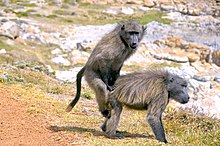Baboon
All baboons have long, dog-like muzzles, heavy, powerful jaws with sharp canine teeth, close-set eyes, thick fur except on their muzzles, short tails, and nerveless, hairless pads of skin on their protruding buttocks called ischial callosities that provide for sitting comfort.Baboons are diurnal and terrestrial, but sleep in trees, or on high cliffs or rocks at night, away from predators.[18][19] Many authors distinguish P. hamadryas as a full species, but regard all the others as subspecies of P. cynocephalus and refer to them collectively as "savanna baboons".[4][20][21] In 2015 researchers found the oldest baboon fossil on record, dated at 2 million years old.[22] All baboons have long, dog-like muzzles, heavy, powerful jaws with sharp canine teeth, close-set eyes, thick fur except on their muzzles, short tails, and rough spots on their protruding buttocks, called ischial callosities.They are omnivorous, highly opportunistic feeders and will eat virtually anything, including grasses, roots, seeds, leaves, bark, fruits, fungus, insects, spiders, worms, fish, shellfish, rodents, birds, vervet monkeys, and small antelopes.They often raid human dwellings, and in South Africa they break into homes and cars in search of food.Large males will often confront them by flashing their eyelids, showing their teeth by yawning, making gestures, and chasing after the intruder/predator.Group sizes are typically around 50 animals, but can vary between 5 and 250, depending on species, location and time of year.[28] Baboon social dynamics can also vary; Robert Sapolsky reported on a troop, known as the Forest Troop, during the 1980s, which experienced significantly less aggressive social dynamics after its most aggressive males died off during a tuberculosis outbreak, leaving a skewed gender ratio of majority females and a minority of low-aggression males.[30] In a wild baboon population of the Amboseli ecosystem in Kenya, inbreeding is avoided by mate choice.[32] Females typically give birth after a six-month gestation, usually to a single infant; twin baboons are rare and often do not survive.Humans infected with Mycobacterium tuberculosis can transmit the disease to the primates upon close proximity.Pathogens have a high likelihood of spreading through humans and species of nonhuman primates, such as baboons.






Baboon (disambiguation)PreꞒPleistoceneOlive baboonYellow baboonScientific classificationEukaryotaAnimaliaChordataMammaliaPrimatesHaplorhiniSimiiformesCercopithecidaePapioniniErxlebenType speciesPapio papioDesmarestPapio hamadryasPapio anubisPapio cynocephalusPapio ursinusPapio kindaeSynonymsBoddaertpreoccupiedHübnergeneraOld World monkeyshamadryas baboonGuinea baboonKinda baboonchacma baboonAfricaArabian Peninsulahominoidcanine teethbuttocksischial callositieshamadryas baboonssexual dimorphismdiurnalterrestrialomnivorousNile crocodilesleopardshyenasharemsdominancespeciessubspecies LC NT LinnaeusrhizomesLönnbergLessoncallusesorthographic processing skillsshellfishvervet monkeysantelopesspottedstriped hyenasblack mambacollective nounGroup sizesmatrilinesocial dynamicsRobert SapolskyChacma baboonsCape PointSouth Africaswollen rumpAmboseli ecosystem in Kenyainbreedingmate choiceinbreeding depressionLake Manyara National ParkTanzaniaphilopatricUitenhageEgyptian mythologyBaboon WomanHerpesvirus papioAmboseli Baboon Research ProjectList of historical monkeysParapapioGroves, C. P.Wilson, D. E.livescience.comMittermeier, Russell A.Wilson, Don E.Animal Diversity WebUniversity of MichiganIUCN Red List of Threatened SpeciesBibcodeAfrican Wildlife FoundationBehaviourA & C BlackBloomsbury PublishingWikispeciesWikisource1911 Encyclopædia BritannicaWayback MachineCercopithecidae (Old World monkeys)CercopithecinaeCercopitheciniAllenopithecusAllen's swamp monkey (A. nigroviridis)MiopithecusAngolan talapoin (M. talapoin)Gabon talapoin (M. ogouensis)ErythrocebusSouthern patas monkey (E. baumstarki)Common patas monkey (E. patas)Blue Nile patas monkey (E. poliophaeus)ChlorocebusDryas monkey (C. dryas)Green monkey (C. sabaeus)Grivet (C. aethiops)Bale Mountains vervet (C. djamdjamensis)Tantalus monkey (C. tantalus)Vervet monkey (C. pygerythrus)Malbrouck (C. cynosuros)